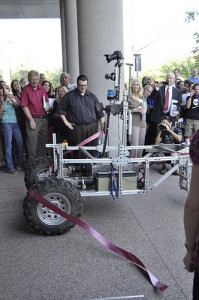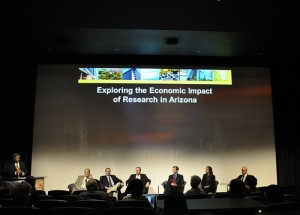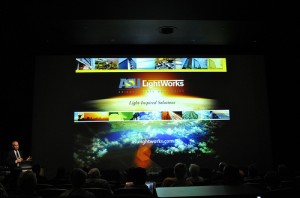October 3, 2012
 Wednesday, September 19, 2012 marked the grand opening of the Interdisciplinary Science and Technology Building IV (ISTB 4) on ASU Tempe campus. In celebration of this event, the Office of Knowledge and Enterprise Development (OKED) hosted a forum discussing how activities and research at ISTB 4 and ASU affect the local economy and state. The “Exploring the Economic Impact of Research in Arizona” forum hosted a renowned group of panelists that represented the fields of research that are now housed at the ISTB 4 building. OKED Senior Vice President, Sethuraman “Panch” Panchanathan, was the moderator of the forum and began with introducing each panelist as a representation of the three interdisciplinary topic areas to discuss: earth and space exploration, security and defense, and energy and sustainability.
Wednesday, September 19, 2012 marked the grand opening of the Interdisciplinary Science and Technology Building IV (ISTB 4) on ASU Tempe campus. In celebration of this event, the Office of Knowledge and Enterprise Development (OKED) hosted a forum discussing how activities and research at ISTB 4 and ASU affect the local economy and state. The “Exploring the Economic Impact of Research in Arizona” forum hosted a renowned group of panelists that represented the fields of research that are now housed at the ISTB 4 building. OKED Senior Vice President, Sethuraman “Panch” Panchanathan, was the moderator of the forum and began with introducing each panelist as a representation of the three interdisciplinary topic areas to discuss: earth and space exploration, security and defense, and energy and sustainability.
Panelists and their research facilities (listed in order of appearance):
Earth and Space Exploration:
Security and Defense:
Energy and Sustainability:
 Dr. Kip Hodges of the School of Earth and Science Exploration (SESE) discussed the school’s area of research that will now be located within the ISTB 4 building. The research areas that SESE concentrates on include planetary systems, earth history/evolution/current state, and the evolution of societies. Hodges emphasized that science is a combination of experimental, theoretical, and observational. Hodges said, “We continue to emphasize observational science, but it does not get its due.” ISTB 4 will host more opportunities to expand observational science, such as geology, in terms of education and research. “We love to concentrate on education”, Hodges said, and also noted plans to develop a strong K-12 outreach program within the building.
Dr. Kip Hodges of the School of Earth and Science Exploration (SESE) discussed the school’s area of research that will now be located within the ISTB 4 building. The research areas that SESE concentrates on include planetary systems, earth history/evolution/current state, and the evolution of societies. Hodges emphasized that science is a combination of experimental, theoretical, and observational. Hodges said, “We continue to emphasize observational science, but it does not get its due.” ISTB 4 will host more opportunities to expand observational science, such as geology, in terms of education and research. “We love to concentrate on education”, Hodges said, and also noted plans to develop a strong K-12 outreach program within the building.
Phil Christensen, also of SESE, discussed his area of interest which is developing Mars research, discovery, and education. Christensen opened with saying, “For me, science is discovery and exploration, but it’s also about new ideas and new ways of thinking.” ISTB 4 will host an outlet for researchers and students to invent, create, and develop technologies needed for the future. Christensen praised the opportunity of education that will be done at ISTB 4 and the importance of “training explorers of tomorrow.”
Werner Dahm of the Security Defense Initiative (SDSI) highlighted the ambitious goals that SDSI plans to have at ISTB 4. Dahm said, “We are establishing entirely new mechanisms here at ASU.” SDSI focus areas are technology, law and policy, and root socio-cultural and socio-economic causes. Because Arizona is fifth on the list of aerospace employment nationally, Dahm expects that the research and education being done in the ISTB 4 building will provide a tremendous economic impact for ASU.
William Chapman spoke on behalf of Raytheon Missile Systems and provided an overview of the various types of missiles that are currently being designed and produced in Tucson, Arizona. Chapman emphasized the point that Raytheon invests in research and that the technology and talent taking place at ASU will be “incredibly important to further and continue missile research.”
 Gary Dirks, director of ASU LightWorks, spoke about sustainability and energy practices that will need to be considered in all areas of education and research for the future. Dirks' focused area of interest was discussing the future of renewable energy in Arizona. Dirks said about LightWorks, “Our vision is to be an active player to new approaches, create a new industry, and encourage consciousness of energy security and energy justice.” Dirks also spoke about the recent accomplishment of the Department of Energy awarding a $15 million grant for ASU to lead the first ever national algae testbed ATP3. “This will provide many commercial opportunities,” Dirks said. “Researchers from all over will want to come to ASU to contribute in this ground breaking research.”
Gary Dirks, director of ASU LightWorks, spoke about sustainability and energy practices that will need to be considered in all areas of education and research for the future. Dirks' focused area of interest was discussing the future of renewable energy in Arizona. Dirks said about LightWorks, “Our vision is to be an active player to new approaches, create a new industry, and encourage consciousness of energy security and energy justice.” Dirks also spoke about the recent accomplishment of the Department of Energy awarding a $15 million grant for ASU to lead the first ever national algae testbed ATP3. “This will provide many commercial opportunities,” Dirks said. “Researchers from all over will want to come to ASU to contribute in this ground breaking research.”
Julie Zimmerman focused on the concept of sustainability and the impact that it has to achieve challenges we wish to see for our city’s future. “It is important to know what problems we want to solve,” Zimmerman said. Through the advancement of technologies and introducing new areas of sustainable design, education and research, sustainability is sure to be instilled in many areas of life and will have a tremendous economic impact. “Sustainability is really about designing for tomorrow,” Zimmerman said.
The forum was then opened into an interactive “Q&A” session. Some of the questions included:
Q. How important is the ISTB 4 building to ASU? What is the value in having interdisciplinary research and activities?
Christensen: “I think it is essential for intellectual development and collaboration. Bringing scientists, engineers, and researches together is fundamental to what a university does.”
Q. What are the economic drivers that will move companies to be more sustainable?
Dirks: “Oil companies will take more interest in biofuels as a commercial opportunity. Oil companies will need places to invest money and those who see climate change as being an issue will be the ones out on the leading edge. I am very optimistic that business is going into this space.”
Q. What is the trade-off for sustainability and renewable energy? Is it conceivable that Arizona could export solar energy?
Zimmerman: “If we implement renewable sources, we won’t have to push for as much conservation and lifestyle changes.”
Dirks: “We can absolutely export solar power. We have to build relationships with our neighbors, particularly California, to work toward advancing solar technologies. Exploring high voltage lines that could reach to Texas or out to the East Coast will be what we need to look into.”
The ISTB 4 building boasts eight-stories into the sky offering a series of complex labs, world-class conference facilities, spaces dedicated to public outreach, and visible laboratories. It is the goal of researchers, such as these panelists, to see their legacy of interdisciplinary research, discovery, education, and outreach continued, and ASU’s ISTB 4 will allow for that accomplishment.
Written by Gabrielle Olson, ASU LightWorks
Photos by Sydney Lines
Additional Information:
https://asunews.asu.edu/20120919_ISTBIV_opening
http://www.flickr.com/photos/asulightworks/sets/72157631607290120/

